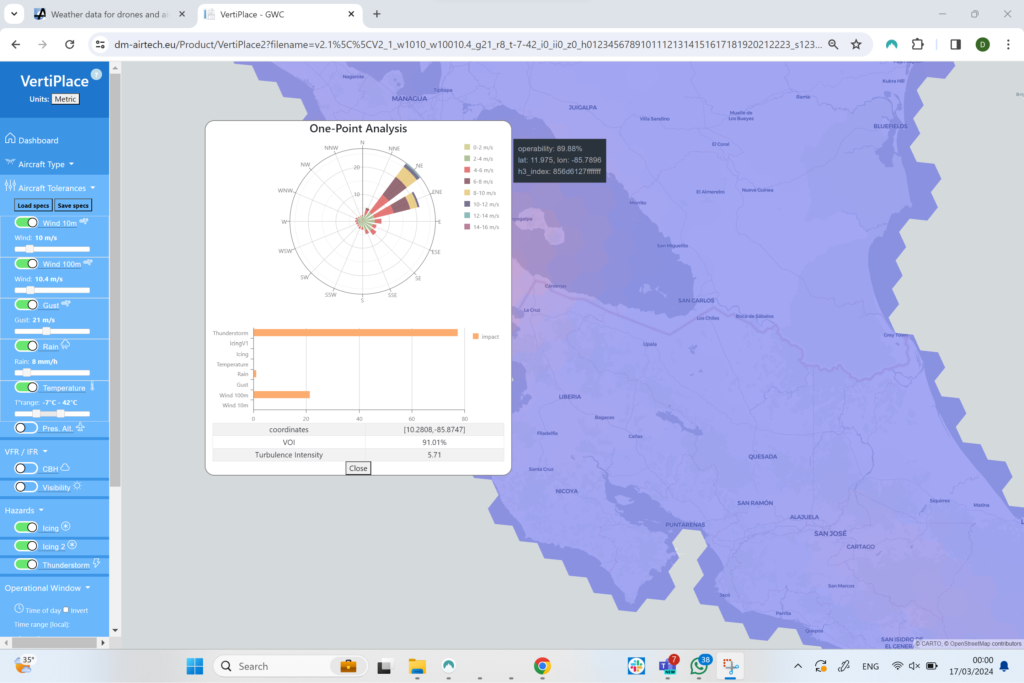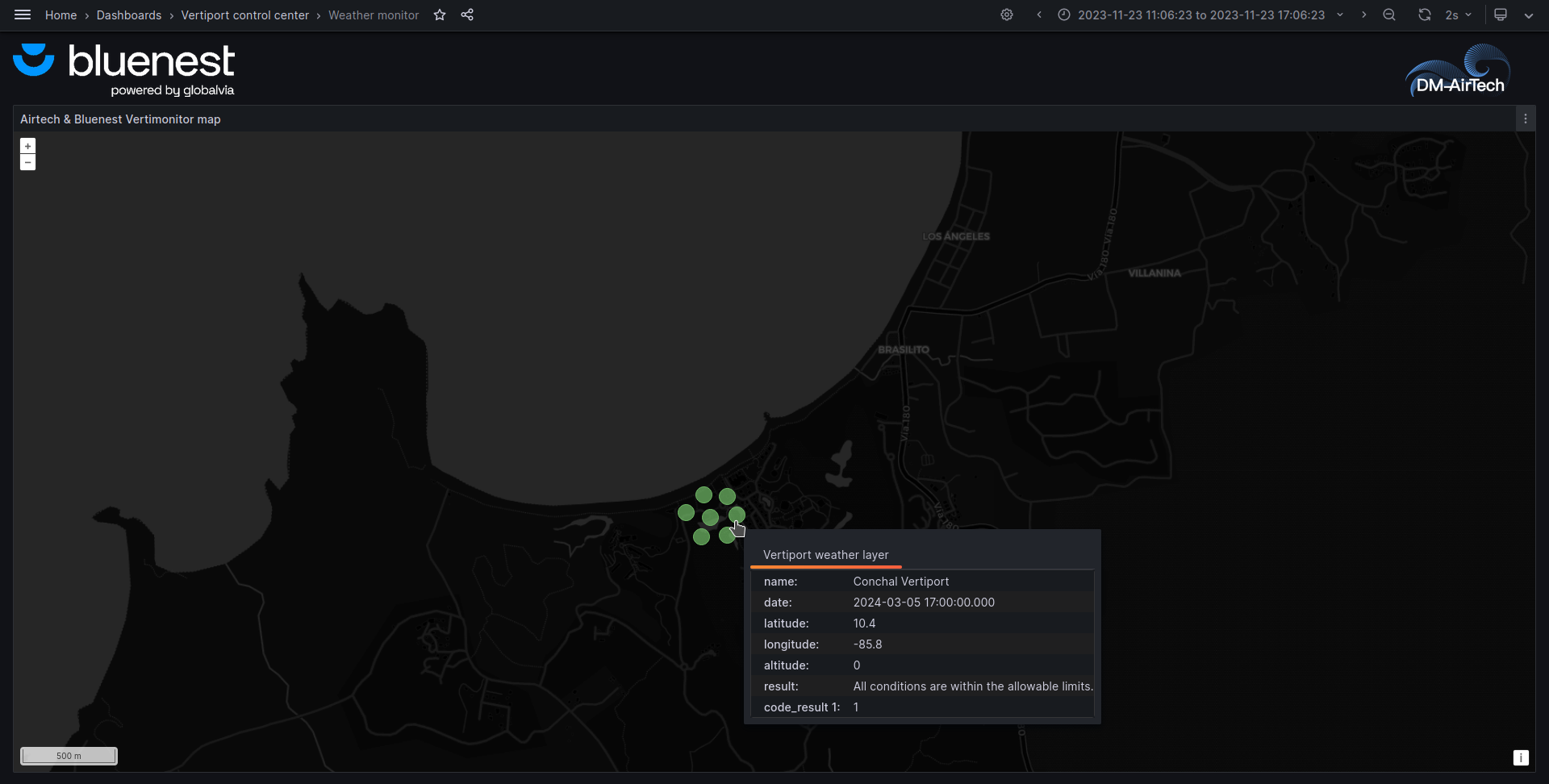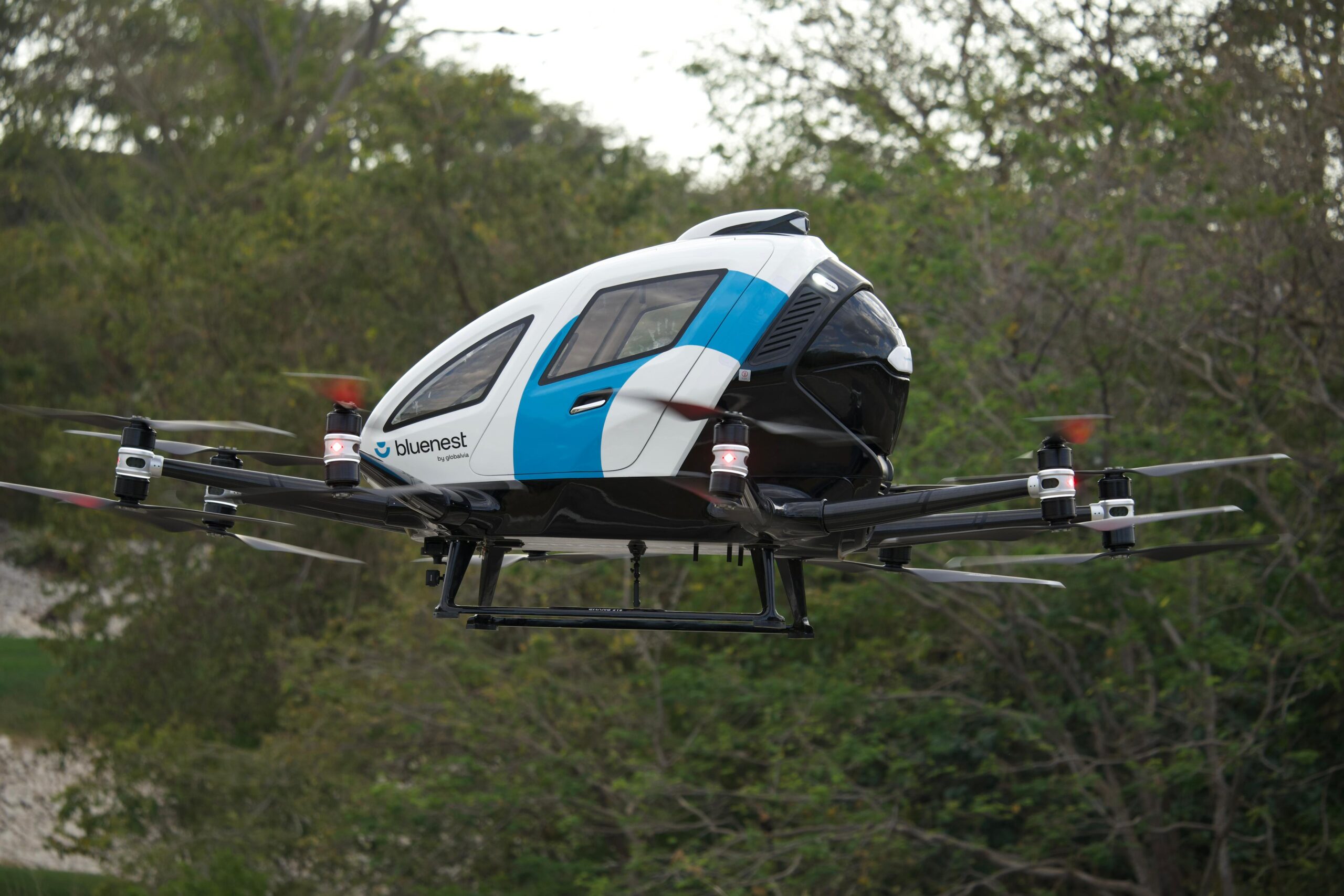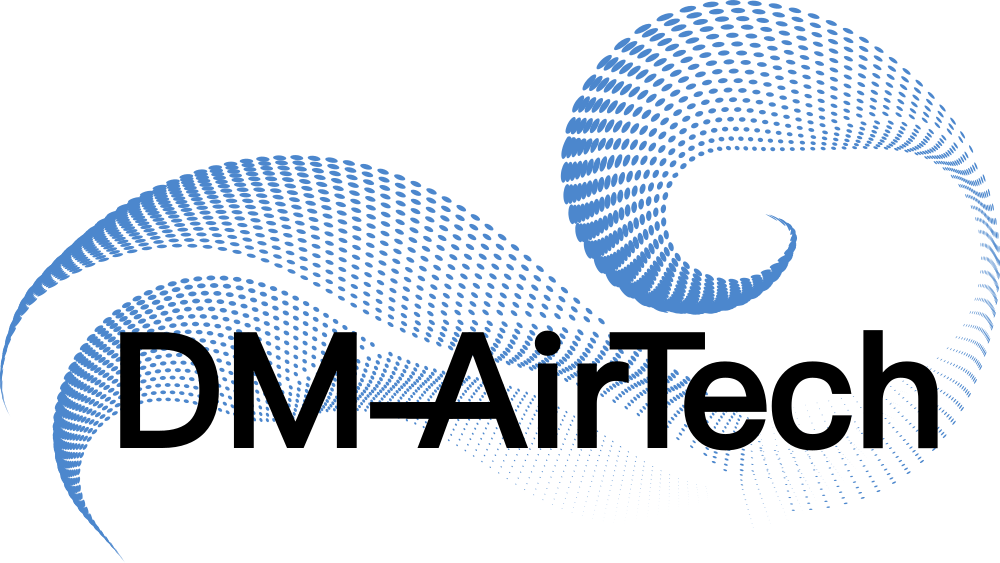Before Event Overview: DM-AirTech is glad to share that their weather analytics for operational planning and execution have been integrated by Bluenest’s Vertiport Control Centre to perform its first demonstration of an autonomous eVTOL in Costa Rica.
Event Overview: In an unprecedented leap towards the future of Urban Air Mobility (UAM), Bluenest by Globalvia, alongside its weather partner DM-AirTech and top of class UAM service providers has successfully conducted the first passenger eVTOL flight demonstration in Latin America. This historic event took place thanks to a collaborative effort between Bluenest by Globalvia, Guanacaste Airport – LIR (a subsidiary of VINCI Airports) and Reserva Conchal (hospitality division of FIFCO), marking a significant milestone in the advancement of sustainable and innovative air mobility solutions in Costa Rica. By flying an electric vertical take-off and landing (eVTOL) aircraft in front of a diverse audience, this event promoted the viability of UAM services for different and multiple purposes e.g. sight seeing, airport shuttle, as well as in for transforming urban and peri-urban mobility.
Bluenest by Globalvia: A hands on team dedicated to make it fly: The success of this flight demonstration has been orchestrated by Bluenest by Globalvia. Their work on stakeholder engagements as well as their hands-on approach, from meticulous planning to seamless execution, demonstrates a profound commitment to advancing UAM through sustainable and innovative solutions.
Outcome for UAM stakeholders: The UAM community will benefit from this demonstration and demonstrations alike because they provide the best possible education to communities and private stakeholders who can and necessarily need to be part of if. Only with this participation it is possible for all the involved parties to critically judge the UAM’s endeavours and to ultimately build meaningful services. Furthermore, the hands on approach driven by the team at Bluenest shed light on the critical technological components that needs to be integrated and well orchestrated in order to accomplish the mission safely. Down the road to the operational environment – beyond the well recognised role of the aircraft – it becomes clear that technology components such as precise tracking, deconfliction and weather analytics assume a central role in the success and performance of UAM services. The spotlight on those components allowed private companies and investors to learn about their value, which we can already see being translated into more comprehensive considerations and investment choices that will benefit the whole UAM community.
Weather analytics in the pre-operational stage: When preparing for a flight operation which involves a broad audience and – in future steps – paying passengers that aim to fly safely and comfortably, the role of weather becomes crystal clear to anyone involved.

Screenshot from the Graphical User Interface of VertiPlace: Analysis of expected service availabilty and weather impact on future operations deplying a generic, autonomous eVTOL below 100m AGL during day and night in Guanacaste.
The worst thing that can happen to those who invested in creating a specific UAM service (for example connecting the International Airport of San José in Costa Rica with surrounding mobility hubs) is to realize that the return on investment (ROI) is two digits lower than expected. This could happen easily when there is a mismatch between the purchased aircraft’s performances and local weather patterns because this will induce more flight cancelations than expected. At DM-AirTech we named this as “Weather Misfit”. Ensuring “Weather Fit” can be achieved by including weather analytics into the decision making. DM-AirTech’s platform VertiPlace was designed to make this effectively. The process of ensuring Weather Fit starts several months to some years prior to first operation. During this time, stakeholders monitor the long term effects that weather will have on business choices they are making e.g. site and aircraft selection, vertiport design and planning or pre-scheduling a service (to name a few). This allows to effectively monitor the impact of those choices in the ROI.
Weather awareness and analytics in the operational stage: Approaching departure time, it becomes more and more vital to have the best weather awareness possible. This includes both the quality of the weather data including observations, forecast modelling but also accurate and meaningful built-in analytics to support the operator to simply and optimally deal with the intricacies of weather. This task falls under DM-AirTech’s mission with the service VertiMonitor, which is integrated by Bluenest in their Vertiport Control Centre and has been employed for this demonstration.

DM-AirTech’s VertiMonitor integrated in Bluenest’s Vertiport Control Centre Dashboard. Demonstration of turning the weather intricacy in a simple go/no go (green/red light) for the operation requested.
The flight demonstration occurred at circa 04:20 PM (local time). Until ca 03:30PM the day was windy, with winds and gusts exceeding the operational tolerances communicated from the Vertiport Control Centre to VertiMonitor via API offering an ideal scenario for validating VertiMonitor’s scheduling effectiveness. The system identified several no-go periods throughout the day due to high winds, particularly at higher altitudes but kept on providing greenlight at the scheduled time which turned out to be the best moment to take off. Through this event, DM-AirTech affirmed its leadership in weather decision-support technology, setting a new standard for navigating the aerial challenges presented by unpredictable weather conditions. Due to the higher than acceptable winds at higher altitudes i.e. >100m AGL, for the demonstration, it was important to feed the weather clearance algorithm with different sources. In the back-end, an algorithm was looking at the combination of atmospheric model data, on-site sensor readings, and METAR reports from the nearest airport. This multi-faceted approach enabled to acquire confidence on the green light that was given for the 04:20 PM flight despite winds that overcome tolerances of the operations communicated from the Vertiport Control Center to VertiMonitor via API. This approach allowed the operator to identify the risk in advance and to manage it effectively, in this case by proceeding with the operation, which has been proven a great choice considering that after 04:00 the winds chilled and the eVTOL performed a great demonstration flight in front of the audience.
Key Takeaways about Weather and UAM:
- The Strategic Advantage of Weather Forecasting: In the precision-oriented operations of Urban Air Mobility (UAM), the ability to schedule flights with a clear understanding of weather conditions days in advance is not just a safety measure—it’s a strategic advantage. The use of accurate data and automation to navigate weather uncertainties becomes indispensable. DM-AirTech’s VertiMonitor is a proven concept-fit for operations employing passenger and cargo drones because it exemplifies this approach by integrating detailed weather forecasts and real-time data, enabling operators to plan with confidence and certainty.
- Addressing the Sensitivity to Winds (and other aircraft tolerances): According to the published aircraft data at our disposal the passenger and cargo drones that are being designed and commercialized are exposed to potentially significant sensitivities to wind conditions presenting a challenge that requires tolerance aware weather analytics to guide the operations.
- Complex operational constrains: For more complex operational scenario than the one where the demonstration has occurred, such as the vicinity of urban environments, it will be impossible to deal with aircraft sensitivity to winds while ensuring operational viability because the winds and turbulence amplification within the urban environment will frequently hit the aircraft limitations. DM-AirTech is at the forefront of this innovation, working diligently to refine the granularity of weather data down to a few meters using computational fluid dynamics. This increased resolution will significantly enhance the ability to understand local weather scenarios, thereby expanding the daily operational window for eVTOL flights.
“Weather the platform i.e. the VTOL is piloted (e.g. Volocopter, Lilium, Archer, Joby, Autoflight, Supernal) or it is autonomous (e.g. Ehang and Wisk), the safe transport of people and goods require the knowledge of weather – and this is not a news. What however keeps on being negletted is that the way weather needs to be dealt with, in this autonomous race, is different than what we are used to from civil aviation. During the deployment in Costa Rica, we have confirmed that VertiMonitor contains the right elements to serve both “autonomous” and the “piloted” platforms. We also confirm that several elements sill need to be puzzled to prepare to manage weather for
(a) UAM in complex conops e.g. in urban environments
(b) high-density output operations.We have been able to identify several of these elements one of which is granularity of wind and turbulence prediction and the second is uncertainty of weather modelling and third is the capability to correlate weather with aircraft performances and limitations. We believe that these steps will unlock the true potential of weather analytics for UAM operations – and we are already working on them and this successful deployment not only confirm that we are on the right track, but also provides new and important input to improve our offering for drones and eVTOLs companies. Stay tuned for updates.” – Dr. Eng. Dario Milani, CEO, DM-AirTech
As we look towards a future where UAM is an integral part of our transportation ecosystem, the role of precise, reliable weather decision-making tools becomes increasingly critical. DM-AirTech, through innovations like VertiMonitor, is at the forefront of this evolution, ensuring that the skies remain safe and accessible for the next generation of air travel.

Bluenest by Globalvia operating Ehang 216 eVTOL in Costa Rica on 14th March, 2024

